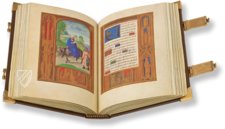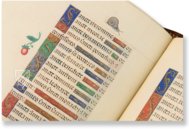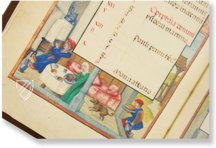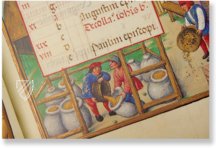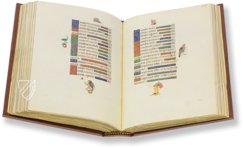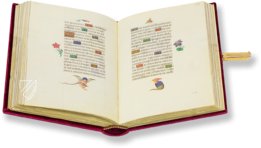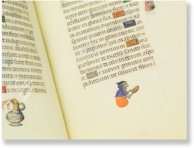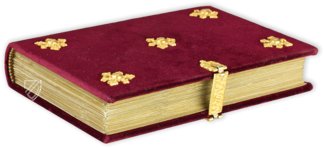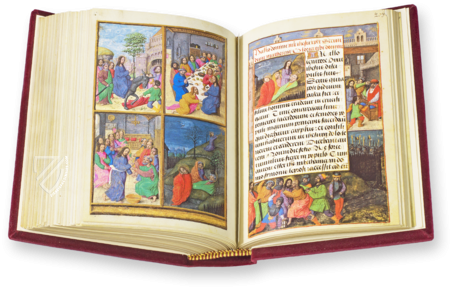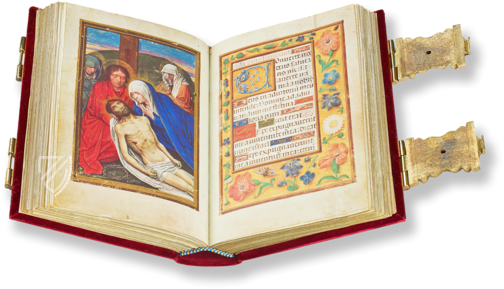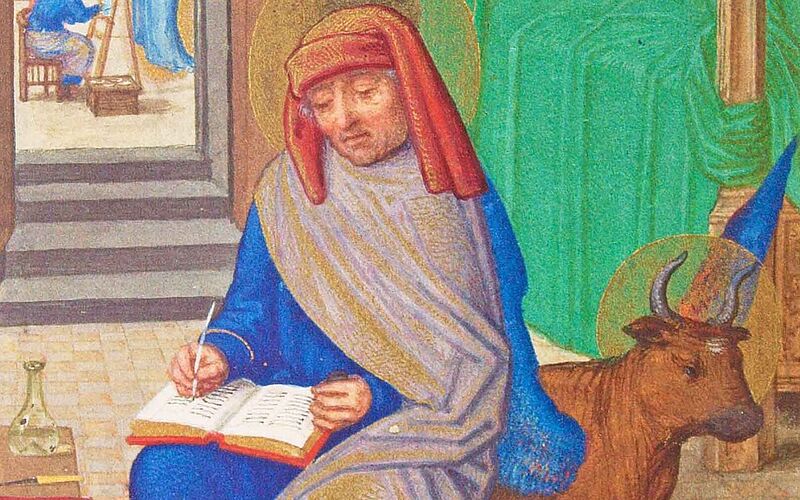Book of Drolleries - The Croy Hours
(1,000€ - 3,000€)
The Croy Hours were written in Bruges between 1510 and 1520 and were probably commissioned by a noblewoman of the court of Hapsburg Burgundy. It boasts so many humorous little images in its margins, so-called drôleries, that it became known as the Book of Drolleries. Also known as grotesques, drôleries are fantastical marginal decorations or vignettes that depict fabulous hybrid creatures from men, animals and plants. With over 200 drôleries, the Croy Hours are a unique book treasure that enchants every beholder with its splendid book illumination, which also includes 70 beautiful illuminations. This treasure trove of late medieval book art is the work of some of the greatest masters of the Ghent-Bruges School: Gerard Horenbout and Simon Bening are responsible for most of the ornate book decoration, but also collaborated with the world-famous panel painter Gerard David for the virtuoso design of this precious work.
Book of Drolleries - The Croy Hours
The Croy Hours, originating from the 16th century, originally bore the name Book of Drolleries. The term “drolleries” indicates a very specific, typical picture cycle for late-medieval illuminated manuscripts, which found its full expression in The Croy Hours. Drolleries are imaginative vignettes in which fairytale hybrid creatures of man and beast or plant are depicted. Alongside over 200 fascinating drolleries, The Croy Hoursis adorned with 58 colorful miniatures in the highest quality, 12 calendar miniatures, and countless gold appliqúes. In terms of content conception, the prayer book conforms to the widely-disseminated medieval book of hours, which was used for quiet prayer and private meditation.
A Book for Aristocratic Houses
To this day, it is not known exactly who commissioned and financed The Croy Hours. It was presumably an unidentified lady of the court of Hapsburg Burgundy. The name Croy goes back to the name of a French Nobleman, Guillaume de Croy recorded on a page of the manuscript. The de Croy family cultivated outstanding relations with the Dukes of Burgundy, John the Fearless and his son Philip the Good and belonged among the wealthiest and powerful Burgundian families. The precious book of hours represents the greatest treasure of their private book collection. At the beginning of the 18th century, Prince Eugene of Savoy acquired the precious work for his library, which belonged among the most comprehensive at that time and which came into the possession of Emperor Charles VI in the year 1738. The Croy Hours have always been an absolute highlight of the imperial collection.
Miniature Art from Bruges
Both of the greatest masters of the renowned Ghent-Bruges school made the miniatures of The Croy Hours. Gerard Hohenbout and Simon Bening created the full-page pictures of the manuscript and decorated the margins with the unique drolleries. Both of the masters worked in accord with the world-famous panel painter Gerard David for the artful design of the work. A few details about the origin of the manuscript still cannot clarified to this day. It is well established that the work was not produced in a single workshop, but instead the splendid design of the masterpiece was implemented throughout several stages of work and at various locations. The refined depictions attest to the unbelievable imagination and creative delight of both of the primary masters, which was supported by artists from various studios. The complicated yet not-fully researched production process contributes to the special appeal of The Croy Hours.
Codicology
- Alternative Titles
- Croy-Gebetbuch
Buch der Drôlerien - Size / Format
- 366 pages / 19.5 × 13.7 cm
- Origin
- Belgium
- Date
- Between 1510 and 1520
- Epochs
- Style
- Genre
- Script
- Gothic Textura Prescissa
- Illustrations
- 58 colourful miniatures, over 200 fantastic drolleries, as well as a great number of decorative elements
- Patron
- Guillaume II. de Croÿ, Seigneur de Chièvres (1458–1521)
- Artist / School
- Gerard Horenbout (1460/65–1540)
Simon Bening (1483–1561)
Gerard David (ca. 1460–1523) - Previous Owners
- Prince Eugene of Savoy (1663–1736)
Emperor Charles VI (1685–1740)
Book of Drolleries - The Croy Hours
Red Roses
During the 15th and 16th centuries, books of hours increasingly featured realistic depictions of plants and they could sometimes even double as a botanical work. Floral imagery was especially popular in manuscripts from the Low Countries, where there was a bustling flower trade that was further invigorated by the recent import of tulips from the Ottoman Empire. This bas-de-page miniature contains depictions of red roses both in bloom and as buds along with a caterpillar and a large fly.

Book of Drolleries - The Croy Hours
June: Storing Hay
Aside from this codex’s namesake “drolleries,” this manuscript is distinguished by its calendar pages, possibly from the hand of Simon Bening. Bening took the typical labor of the month and enhanced it with wonderful landscapes and even cityscapes. Each month received two such depictions in the manuscript, including the present recto page from the month of June.
Beneath the Cancer zodiac sign, this labor of the month shows the aftermath of the verso page (not pictured), in which hay is harvested. The dried hay is being bundled and hoisted into a warehouse by means of a pulley. Although appearing in the margins around the text written in red and brown ink, the architecture to the right and the landscape to the left indicate a masterly use of perspective.

#1 Croy-Gebetbuch Buch der Drôlerien (Deluxe Edition)
Languages: German, French
(1,000€ - 3,000€)
#2 Croy-Gebetbuch Buch der Drôlerien (Standard Edition)
Languages: German, French
(1,000€ - 3,000€)
#3 Croy-Gebetbuch Buch der Drôlerien (Red Velvet Edition)
Languages: German, French
- Treatises / Secular Books
- Apocalypses / Beatus
- Astronomy / Astrology
- Bestiaries
- Bibles / Gospels
- Chronicles / History / Law
- Geography / Maps
- Saints' Lives
- Islam / Oriental
- Judaism / Hebrew
- Single Leaf Collections
- Leonardo da Vinci
- Literature / Poetry
- Liturgical Manuscripts
- Medicine / Botany / Alchemy
- Music
- Mythology / Prophecies
- Psalters
- Other Religious Books
- Games / Hunting
- Private Devotion Books
- Other Genres
- Afghanistan
- Armenia
- Austria
- Belgium
- Belize
- Bosnia and Herzegovina
- China
- Colombia
- Costa Rica
- Croatia
- Cyprus
- Czech Republic
- Denmark
- Egypt
- El Salvador
- Ethiopia
- France
- Germany
- Greece
- Guatemala
- Honduras
- Hungary
- India
- Iran
- Iraq
- Israel
- Italy
- Japan
- Jordan
- Kazakhstan
- Kyrgyzstan
- Lebanon
- Liechtenstein
- Luxembourg
- Mexico
- Morocco
- Netherlands
- Palestine
- Panama
- Peru
- Poland
- Portugal
- Romania
- Russia
- Serbia
- Spain
- Sri Lanka
- Sweden
- Switzerland
- Syria
- Tajikistan
- Turkey
- Turkmenistan
- Ukraine
- United Kingdom
- United States
- Uzbekistan
- Vatican City
- A. Oosthoek, van Holkema & Warendorf
- Aboca Museum
- Ajuntament de Valencia
- Akademie Verlag
- Akademische Druck- u. Verlagsanstalt (ADEVA)
- Aldo Ausilio Editore - Bottega d’Erasmo
- Alecto Historical Editions
- Alkuin Verlag
- Almqvist & Wiksell
- Amilcare Pizzi
- Andreas & Andreas Verlagsbuchhandlung
- Archa 90
- Archiv Verlag
- Archivi Edizioni
- Arnold Verlag
- ARS
- Ars Magna
- ArtCodex
- AyN Ediciones
- Azimuth Editions
- Badenia Verlag
- Bärenreiter-Verlag
- Belser Verlag
- Belser Verlag / WK Wertkontor
- Benziger Verlag
- Bernardinum Wydawnictwo
- BiblioGemma
- Biblioteca Apostolica Vaticana (Vaticanstadt, Vaticanstadt)
- Bibliotheca Palatina Faksimile Verlag
- Bibliotheca Rara
- Boydell & Brewer
- Bramante Edizioni
- Bredius Genootschap
- Brepols Publishers
- British Library
- C. Weckesser
- Caixa Catalunya
- Canesi
- CAPSA, Ars Scriptoria
- Caratzas Brothers, Publishers
- Carus Verlag
- Casamassima Libri
- Centrum Cartographie Verlag GmbH
- Chavane Verlag
- Christian Brandstätter Verlag
- Circulo Cientifico
- Club Bibliófilo Versol
- Club du Livre
- CM Editores
- Collegium Graphicum
- Collezione Apocrifa Da Vinci
- Comissão Nacional para as Comemorações dos Descobrimentos Portugueses
- Coron Verlag
- Corvina
- CTHS
- D. S. Brewer
- Damon
- De Agostini/UTET
- De Nederlandsche Boekhandel
- De Schutter
- Deuschle & Stemmle
- Deutscher Verlag für Kunstwissenschaft
- DIAMM
- Droz
- E. Schreiber Graphische Kunstanstalten
- Ediciones Boreal
- Ediciones Grial
- Ediclube
- Edições Inapa
- Edilan
- Editalia
- Edition Deuschle
- Edition Georg Popp
- Edition Leipzig
- Edition Libri Illustri
- Editiones Reales Sitios S. L.
- Éditions de l'Oiseau Lyre
- Editions Medicina Rara
- Editorial Casariego
- Editorial Mintzoa
- Editrice Antenore
- Editrice Velar
- Edizioni Edison
- Egeria, S.L.
- Eikon Editores
- Electa
- Emery Walker Limited
- Enciclopèdia Catalana
- Eos-Verlag
- Ephesus Publishing
- Ernst Battenberg
- Eugrammia Press
- Extraordinary Editions
- Fackelverlag
- Facsimila Art & Edition
- Facsimile Editions Ltd.
- Facsimilia Art & Edition Ebert KG
- Faksimile Verlag
- Feuermann Verlag
- Folger Shakespeare Library
- Franco Cosimo Panini Editore
- Friedrich Wittig Verlag
- Fundación Hullera Vasco-Leonesa
- G. Braziller
- Gabriele Mazzotta Editore
- Gebr. Mann Verlag
- Gesellschaft für graphische Industrie
- Getty Research Institute
- Giovanni Domenico de Rossi
- Giunti Editore
- Graffiti
- Grafica European Center of Fine Arts
- Guido Pressler
- Guillermo Blazquez
- Gustav Kiepenheuer
- H. N. Abrams
- Harrassowitz
- Harvard University Press
- Helikon
- Hendrickson Publishers
- Henning Oppermann
- Herder Verlag
- Hes & De Graaf Publishers
- Hoepli
- Holbein-Verlag
- Houghton Library
- Hugo Schmidt Verlag
- Idion Verlag
- Il Bulino, edizioni d'arte
- ILte
- Imago
- Insel Verlag
- Insel-Verlag Anton Kippenberger
- Instituto de Estudios Altoaragoneses
- Instituto Nacional de Antropología e Historia
- Introligatornia Budnik Jerzy
- Istituto dell'Enciclopedia Italiana - Treccani
- Istituto Ellenico di Studi Bizantini e Postbizantini
- Istituto Geografico De Agostini
- Istituto Poligrafico e Zecca dello Stato
- Italarte Art Establishments
- Jan Thorbecke Verlag
- Johnson Reprint Corporation
- Josef Stocker
- Josef Stocker-Schmid
- Jugoslavija
- Karl W. Hiersemann
- Kasper Straube
- Kaydeda Ediciones
- Kindler Verlag / Coron Verlag
- Kodansha International Ltd.
- Konrad Kölbl Verlag
- Kurt Wolff Verlag
- La Liberia dello Stato
- La Linea Editrice
- La Meta Editore
- Lambert Schneider
- Landeskreditbank Baden-Württemberg
- Leo S. Olschki
- Les Incunables
- Liber Artis
- Library of Congress
- Libreria Musicale Italiana
- Lichtdruck
- Lito Immagine Editore
- Lumen Artis
- Lund Humphries
- M. Moleiro Editor
- Maison des Sciences de l'homme et de la société de Poitiers
- Manuscriptum
- Martinus Nijhoff
- Maruzen-Yushodo Co. Ltd.
- MASA
- Massada Publishers
- McGraw-Hill
- Metropolitan Museum of Art
- Militos
- Millennium Liber
- Müller & Schindler
- Nahar - Stavit
- Nahar and Steimatzky
- National Library of Wales
- Neri Pozza
- Nova Charta
- Oceanum Verlag
- Odeon
- Orbis Mediaevalis
- Orbis Pictus
- Österreichische Staatsdruckerei
- Oxford University Press
- Pageant Books
- Parzellers Buchverlag
- Patrimonio Ediciones
- Pattloch Verlag
- PIAF
- Pieper Verlag
- Plon-Nourrit et cie
- Poligrafiche Bolis
- Presses Universitaires de Strasbourg
- Prestel Verlag
- Princeton University Press
- Prisma Verlag
- Priuli & Verlucca, editori
- Pro Sport Verlag
- Propyläen Verlag
- Pytheas Books
- Quaternio Verlag Luzern
- Reales Sitios
- Recht-Verlag
- Reichert Verlag
- Reichsdruckerei
- Reprint Verlag
- Riehn & Reusch
- Roberto Vattori Editore
- Rosenkilde and Bagger
- Roxburghe Club
- Salerno Editrice
- Saltellus Press
- Sandoz
- Sarajevo Svjetlost
- Schöck ArtPrint Kft.
- Schulsinger Brothers
- Scolar Press
- Scrinium
- Scripta Maneant
- Scriptorium
- Shazar
- Siloé, arte y bibliofilia
- SISMEL - Edizioni del Galluzzo
- Sociedad Mexicana de Antropología
- Société des Bibliophiles & Iconophiles de Belgique
- Soncin Publishing
- Sorli Ediciones
- Stainer and Bell
- Studer
- Styria Verlag
- Sumptibus Pragopress
- Szegedi Tudomànyegyetem
- Taberna Libraria
- Tarshish Books
- Taschen
- Tempus Libri
- Testimonio Compañía Editorial
- Thames and Hudson
- The Clear Vue Publishing Partnership Limited
- The Facsimile Codex
- The Folio Society
- The Marquess of Normanby
- The Richard III and Yorkist History Trust
- Tip.Le.Co
- TouchArt
- TREC Publishing House
- TRI Publishing Co.
- Trident Editore
- Tuliba Collection
- Typis Regiae Officinae Polygraphicae
- Union Verlag Berlin
- Universidad de Granada
- University of California Press
- University of Chicago Press
- Urs Graf
- Vallecchi
- Van Wijnen
- VCH, Acta Humaniora
- VDI Verlag
- VEB Deutscher Verlag für Musik
- Verlag Anton Pustet / Andreas Verlag
- Verlag Bibliophile Drucke Josef Stocker
- Verlag der Münchner Drucke
- Verlag für Regionalgeschichte
- Verlag Styria
- Vicent Garcia Editores
- W. Turnowski Ltd.
- W. Turnowsky
- Waanders Printers
- Wiener Mechitharisten-Congregation (Wien, Österreich)
- Wissenschaftliche Buchgesellschaft
- Wissenschaftliche Verlagsgesellschaft
- Wydawnictwo Dolnoslaskie
- Xuntanza Editorial
- Zakład Narodowy
- Zollikofer AG




